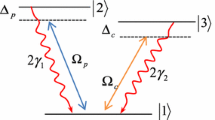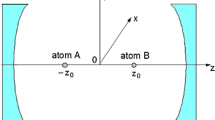Abstract
We study the entanglement dynamics of a pair of identical three-level V-type atoms that are interacting with a common vacuum reservoir. The effect of vacuum-induced coherence in the spontaneous emission of atoms is included in the atomic dynamics. By considering qubits formed from each atom, the entanglement dynamics of the two-qubit system is studied using concurrence as the entanglement measure. We analytically calculate the time evolution of the concurrence for initial entangled states and show that the entanglement among qubits can be preserved in the longtime limit due to vacuum-induced coherence. We demonstrate that the combined effects of vacuum-induced coherence and collective decay of atoms in the common reservoir can protect the entanglement to a better extent in comparison with the case of atoms radiating independently.








Similar content being viewed by others
Data availability
Data sharing is not applicable to this article as no datasets were generated or analyzed during the current study.
References
Nielsen, M.A., Chuang, I.L.: Quantum Computation and Quantum Information. Cambridge University Press, Cambridge (2004)
Zurek, W.H.: Decoherence and the transition from quantum to classical. Phys. Today 44, 36 (1991)
Zheng, S.-B., Guo, G.-C.: Efficient scheme for two-atom entanglement and quantum information processing in cavity QED. Phys. Rev. Lett. 85, 2392 (2000)
Sørensen, A.S., Mølmer, K.: Measurement induced entanglement and quantum computation with atoms in optical cavities. Phys. Rev. Lett. 91, 097905 (2003)
Kastoryano, M.J., Reiter, F., Sørensen, A.S.: Dissipative preparation of entanglement in optical cavities. Phys. Rev. Lett. 106, 090502 (2011)
Lin, Y., Gaebler, J.P., Reiter, F., Tan, T.R., Bowler, R., Sørensen, A.S., Leibfried, D., Wineland, D.J.: Dissipative production of maximally entangled steady state of two quantum bits. Nature (London) 504, 415 (2013)
Yu, T., Eberly, J.H.: Finite-time disentanglement via spontaneous emission. Phys. Rev. Lett. 93, 140404 (2004)
Almeida, M.P., de Melo, F., Hor-Meyll, M., Salles, A., Walborn, S.P., Souto Ribeiro, P.H., Davidovich, L.: Environment-induced sudden death of entanglement. Science 316, 579 (2007)
Ikram, M., Li, F.L., Zubairy, M.S.: Disentanglement in a two-qubit system subjected to dissipation environments. Phys. Rev. A 75, 062336 (2007)
Bellomo, B., LoFranco, R., Compagno, G.: Non-Markovian effects on the dynamics of entanglement. Phys. Rev. Lett. 99, 160502 (2007)
Tahira, R., Ikram, M., Azim, T., Zubairy, M.S.: Entanglement dynamics of a pure bipartite system in dissipative environments. J. Phys. B 41, 205501 (2008)
Bellomo, B., LoFranco, R., Compagno, G.: Entanglement dynamics of two independent qubits in environments with and without memory. Phys. Rev. A 77, 032342 (2008)
Dajka, J., Mierzejewski, M., Łuczka, J.: Non-Markovian entanglement evolution of two uncoupled qubits. Phys. Rev. A 77, 042316 (2008)
Rau, A.R.P., Ali, M., Alber, G.: Hastening, delaying, or averting sudden death of quantum entanglement. Europhys. Lett. 82, 40002 (2008)
Singh, A., Pradyumna, S., Rau, A.R.P., Sinha, U.: Manipulation of entanglement sudden death in an all-optical setup. J. Opt. Soc. Am. B 34, 681 (2017)
Jakóbczyk, L.: Entangling two qubits by dissipation. J. Phys. A 35, 6383 (2002); 36, 1537 (2003) Corrigendum
Ficek, Z., Tanaś, R.: Delayed sudden birth of entanglement. Phys. Rev. A 77, 054301 (2008)
Almutairi, K., Tanaś, R., Ficek, Z.: Generating two-photon entangled states in a driven two-atom system. Phys. Rev. A 84, 013831 (2011)
Ficek, Z., Tanaś, R.: Dark periods and revivals of entanglement in a two-qubit system. Phys. Rev. A 74, 024304 (2006)
Mazzola, L., Maniscalco, S., Piilo, J., Suominen, K.-A., Garraway, B.M.: Sudden death and sudden birth of entanglement in common structured reservoirs. Phys. Rev. A 79, 042302 (2009)
Nourmandipour, A., Tavassoly, M.K., Rafiee, M.: Dynamics and protection of entanglement in n-qubit systems within Markovian and non-Markovian environments. Phys. Rev. A 93, 022327 (2016)
Cecoi, E., Ciornea, V., Isar, A., Macovei, M.: Entanglement of a laser-driven pair of two-level qubits via its phonon environment. J. Opt. Soc. Am. B 35, 1127 (2018)
Vovcenko, I.V., Shishkov, V.Y., Andrianov, E.S.: Dephasing-assisted entanglement in a system of strongly coupled qubits. Opt. Express 29, 9685 (2021)
Hernandez, M., Orszag, M.: Decoherence and disentanglement for two qubits in a common squeezed reservoir. Phys. Rev. A 78, 042114 (2008)
Manirul Ali, Md., Chen, P.-W., Goan, H.-S.: Decoherence-free subspace and disentanglement dynamics for two qubits in a common non-Markovian squeezed reservoir. Phys. Rev. A 82, 022103 (2010)
Maniscalco, S., Francica, F., Zaffino, R.L., Lo Gullo, N., Plastina, F.: Protecting entanglement via the quantum Zeno effect. Phys. Rev. Lett. 100, 090503 (2008)
Zong, X.L., Du, C.Q., Yang, M., Yang, Q., Cao, Z.L.: Protecting remote bipartite entanglement against amplitude dam** by local unitary operations. Phys. Rev. A 90, 062345 (2014)
Cardimona, D.A., Raymer, M.G., Stroud, C.R.: Steady-state quantum interference in resonance fluorescence. J. Phys. B 15, 55 (1982)
Zhu, S.Y., Chan, R.C.F., Lee, C.P.: Spontaneous emission from a three-level atom. Phys. Rev. A 52, 710 (1995)
Paspalakis, E., Knight, P.L.: Phase control of spontaneous emission. Phys. Rev. Lett. 81, 293 (1998)
Paspalakis, E., Keitel, C.H., Knight, P.L.: Fluorescence control through multiple interference mechanisms. Phys. Rev. A 58, 4868 (1998)
Evers, J., Bullock, D., Keitel, C.H.: Dark state suppression and narrow fluorescent feature in a laser-driven \(\Lambda \) atom. Opt. Commun. 209, 173 (2002)
Macovei, M., Evers, J., Keitel, C.H.: Phase control of collective quantum dynamics. Phys. Rev. Lett. 91, 233601 (2003)
Macovei, M., Evers, J., Keitel, C.H.: Coherent manipulation of collective three-level systems. Phys. Rev. A 71, 033802 (2005)
Kiffner, M., Evers, J., Keitel, C.H.: Quantum interference enforced by time-energy complementarity. Phys. Rev. Lett. 96, 100403 (2006)
Kiffner, M., Evers, J., Keitel, C.H.: Interference in the resonance fluorescence of two incoherently coupled transitions. Phys. Rev. A 73, 063814 (2006)
Evers, J., Kiffner, M., Macovei, M., Keitel, C.H.: Geometry-dependent dynamics of two \(\Lambda \)-type atoms via vacuum-induced coherences. Phys. Rev. A 73, 023804 (2006)
Arun, R.: Interference-induced splitting of resonances in spontaneous emission. Phys. Rev. A 77, 033820 (2008)
Schmid, S.I., Evers, J.: Interplay of vacuum-mediated inter- and intra-atomic couplings in a pair of atoms. Phys. Rev. A 81, 063805 (2010)
Arun, R.: Interference-assisted squeezing in fluorescence radiation. Phys. Lett. A 377, 200 (2013)
Crispin, H.B., Arun, R.: Fluorescence control through vacuum induced coherences. J. Phys. B 52, 075402 (2019)
Crispin, H.B., Arun, R.: Squeezing in resonance fluorescence via vacuum induced coherences. J. Phys. B 53, 055402 (2020)
Gong, S.Q., Paspalakis, E., Knight, P.L.: Effects of spontaneous emission interference on population inversions of a V-type atom. J. Mod. Opt. 45, 2433 (1998)
Paspalakis, E., Gong, S.Q., Knight, P.L.: Spontaneous emission-induced coherent effects in absorption and dispersion of a V-type three-level atom. Opt. Commun. 152, 293 (1998)
Dong, P., Tang, S.H.: Absorption spectrum of a V-type three-level atom driven by a coherent field. Phys. Rev. A 65, 033816 (2002)
Arun, R.: Superluminal light propagation via quantum interference in decay channels. Phys. Rev. A 94, 043843 (2016)
Ficek, Z., Swain, S.: Quantum Interference and Coherence: Theory and Experiments. Springer, New York (2005)
Kiffner, M., Macovei, M., Evers, J., Keitel, C.H.: In: Wolf, E. (ed.) Progress in Optics, vol. 55, pp. 85–197. Elsevier Science, Burlington (2010)
Dutt, M.V.G., Cheng, J., Li, B., Xu, X., Li, X., Berman, P.R., Steel, D.G., Bracker, A.S., Gammon, D., Economou, S.E., Liu, R.B., Sham, L.J.: Stimulated and spontaneous optical generation of electron spin coherence in charged GaAs quantum dots. Phys. Rev. Lett. 94, 227403 (2005)
Norris, D.G., Orozco, L.A., Barberis-Blostein, P., Carmichael, H.J.: Observation of ground-state quantum beats in atomic spontaneous emission. Phys. Rev. Lett. 105, 123602 (2010)
Heeg, K.P., Wille, H.C., Schlage, K., Guryeva, T., Schumacher, D., Uschmann, I., Schulze, K.S., Marx, B., Kömpfer, T., Paulus, G.G., Röhlsberger, R., Evers, J.: Vacuum-assisted generation and control of atomic coherences at X-ray energies. Phys. Rev. Lett. 111, 073601 (2013)
Heeg, K.P., Evers, J.: X-ray quantum optics with M\(\ddot{o}\)ssbauer nuclei embedded in thin-film cavities. Phys. Rev. A 88, 043828 (2013)
Das, S., Agarwal, G.S.: Protecting bipartite entanglement by quantum interferences. Phys. Rev. A 81, 052341 (2010)
Nair, A.N., Arun, R.: Comment on Protecting bipartite entanglement by quantum interferences. Phys. Rev. A 97, 036301 (2018)
Das, S., Agarwal, G.S.: Reply to comment on protecting bipartite entanglement by quantum interferences. Phys. Rev. A 97, 036302 (2018)
Iliopoulos, N., Terzis, A.F., Yannopapas, V., Paspalakis, E.: Prolonging entanglement dynamics near periodic plasmonic nanostructures. Phys. Rev. B 96, 075405 (2017)
Ficek, Z., Tanaś, R.: Quantum-Limit Spectroscopy Chap. 8. Springer, New York (2017)
Wootters, W.K.: Entanglement of formation of an arbitrary state of two qubits. Phys. Rev. Lett. 80, 2245 (1998)
Zhou, P., Swain, S.: Cavity engineering of quantum interference. Opt. Commun. 179, 267 (2000)
Yang, Y., Xu, J., Chen, H., Zhu, S.: Quantum interference enhancement with left-handed materials. Phys. Rev. Lett. 100, 043601 (2008)
Yannopapas, V., Paspalakis, E., Vitanov, N.V.: Plasmon-induced enhancement of quantum interference near metallic nanostructures. Phys. Rev. Lett. 103, 063602 (2009)
Derkacz, Ł, Jakóbczyk, L.: Quantum interference and evolution of entanglement in a system of three-level atoms. Phys. Rev. A 74, 032313 (2006)
Author information
Authors and Affiliations
Corresponding author
Ethics declarations
Conflict of interest
The authors have no competing interests and financial/non-financial interests to disclose.
Additional information
Publisher's Note
Springer Nature remains neutral with regard to jurisdictional claims in published maps and institutional affiliations.
Appendix equations of motion
Appendix equations of motion
The density matrix elements written in the basis (4) obey the coupled differential equations obtained from the master equation (1). The equations for the time-evolving density matrix elements are given by
The other density matrix elements are decoupled from the above equations and are identically zero at all times with the initial conditions considered in this paper.
Rights and permissions
Springer Nature or its licensor holds exclusive rights to this article under a publishing agreement with the author(s) or other rightsholder(s); author self-archiving of the accepted manuscript version of this article is solely governed by the terms of such publishing agreement and applicable law.
About this article
Cite this article
Nair, A.N., Arun, R. Protecting bipartite entanglement by collective decay and quantum interferences. Quantum Inf Process 21, 272 (2022). https://doi.org/10.1007/s11128-022-03605-7
Received:
Accepted:
Published:
DOI: https://doi.org/10.1007/s11128-022-03605-7




